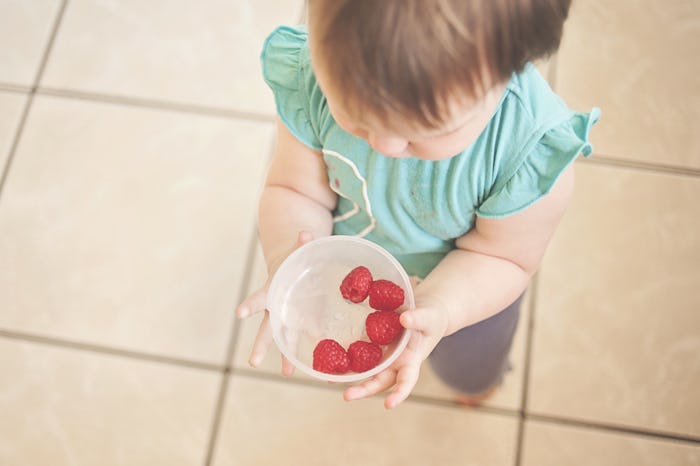Sending your toddler to school isn’t easy. There’s the task of finding the right school, choosing a backpack, and, well, trying not to have a nervous breakdown when you drop them off for the first time. Of course, depending on the type of program, you might also have to pack a lunch for your kid. That can be tough because A, you’ve never done it before and have no idea what to pack, and B, lunch time at home can be a challenge. (Toddlers, right?) To help, here’s what to pack in a toddler's school lunch, according to experts.
“Parents want to make sure to include foods that provide nutrients the toddler needs in order to grow and thrive,” Toby Amidor, MS, a registered dietitian and author of The Healthy Meal Prep Cookbook, tells Romper in an email interview. “These include fruits, vegetables, dairy, lean protein, and whole grains.”
Sarah Remmer, a registered dietitian and nutritionist, says she recommends parents pack four to five different nutritious foods, including two protein-rich foods, at least one fruit and one vegetable, and a whole grain food.
“Toddlers love finger foods, so I often suggest to send a ‘finger-food lunch,’” Remmer says in an email interview with Romper. “Some go-tos are cut up leftover meat, cheese strings or cubes, whole grain crackers, cut up fruit, raw veggie sticks, hummus, greek yogurt, homemade muffins, unsweetened fruit and veggie sauces, or squeeze packs you can find in the applesauce aisle.”
If your toddler is a picky eater because, well, toddlers, then Amidor says keep in mind that all kids are different. For instance, her son did not like any fruit, but loved green vegetables. On the other hand, one of her daughters loved avocado, so she would pack a spoon and half of a very ripe avocado tightly wrapped every day for her. Both children were getting nutritious foods, just not the same ones.
But don’t let choosy eating get in the way of offering your child new, healthy foods, Amidor says. “Give your child some time to learn and taste the foods at home,” she says. “Once they accept them, you can start introducing them into their lunch box.
But no matter the foods you choose for your toddler, Amidor cautions that parents should make sure food is in bite-size pieces to make it easier for small fingers and mouths. “Plus, smaller, bite-size pieces make it less of a choking hazard,” she adds.
Remmer says parents should also send foods in containers that are easily accessible. Small resealable containers or bento boxes, like Yumbox, are useful options. “Test out each container beforehand and practice with your toddler to make sure that he or she can open and close it on their own,” she says.
As for that first drop off, I hear it's necessary to bring the tissues — for you and for them. This is one of those things that gets easier with time, right? (And at least you know they have a great lunch waiting for them.)
